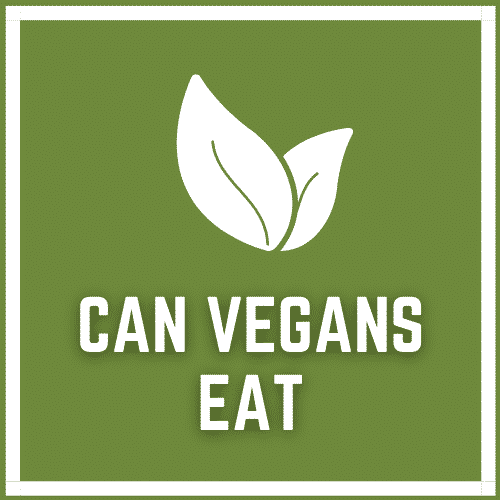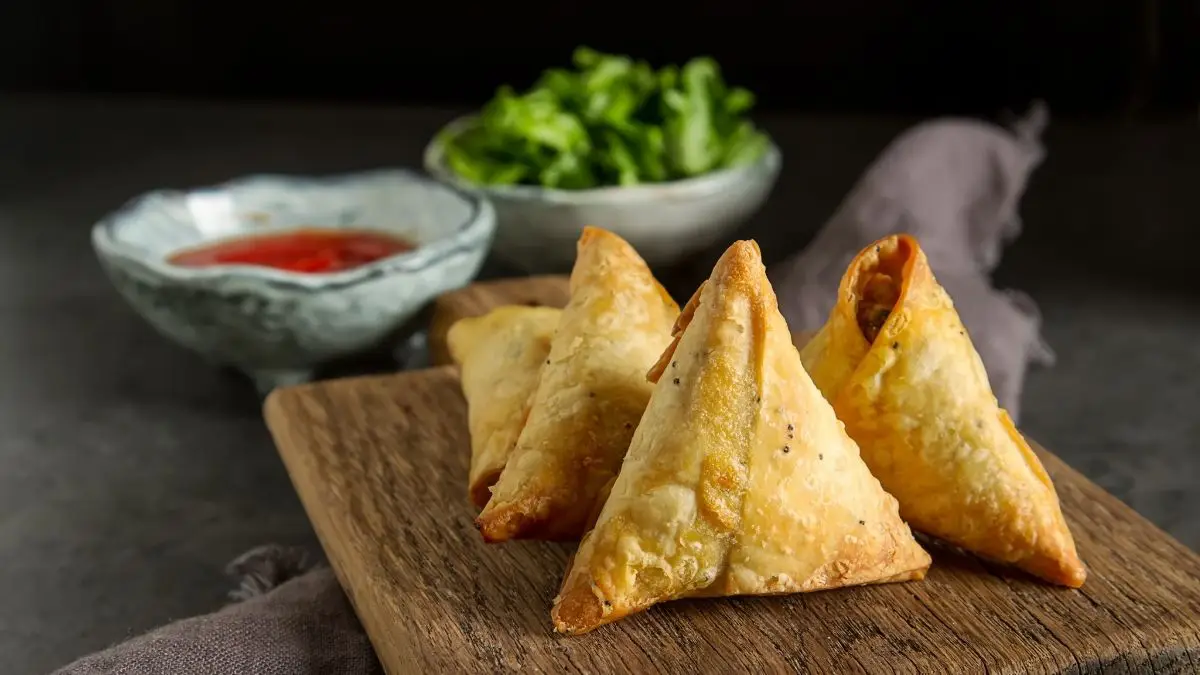Answer: It depends.

A samosa is a food that resembles a stuffed dumpling. It is then fried or baked. Samosas are one of the most common snack foods in India. They can come in different shapes and sizes. However, the most common samosas are triangular, shaped like a cone or a half-moon.
Well, the answer is yes and no. It depends on who is making the samosa and where it’s being made. Some samosas are vegan, and some aren’t. The main difference is the inclusion of meat in the filling. The dough doesn’t contain eggs.
In India, you’ll find that samosas are deep-fried. This is the traditional way to cook them. In the West, they are baked for convenience and health reasons. White flour is generally utilized for the dough, but filo pastry and flour tortillas are used as alternatives.
Table of Contents
Are They Vegan?
Whether your samosa is vegan or not depends entirely on the ingredients that go into making the samosa. Here are some of the popular non-vegan elements you can find in samosas. This list will help you avoid these ingredients.
Meat and Cheese
Samosas are stuffed with various ingredients. The stuffing changes according to the tastes of the people of the region where it is made. The most common vegetarian filling for samosas is potato, peas, lentils, and spices.
In many regions where samosas are made, they are stuffed with meat like lamb, beef, or chicken. A majority of vegan samosas contain a higher amount of chickpeas and lentils. These are used in higher quantities in vegan samosas because they act as a perfect meat substitute.
Vegetarian samosas are very popular, so you’ll find the classic potato-stuffed samosa everywhere. Since vegetarians don’t avoid dairy products, you’ll find many vegetarian samosas stuffed with cheese. As vegans, it’s good to find out what’s in a samosa before eating it.
Fish
There are many varieties when it comes to samosa if you visit different Indian regions. In Bengal, you’ll find variants like fish samosa and mutton samosa. Out of the large number of samosas we saw, fish was probably the least common ingredient. However, fish samosas do exist.
Eggs
Samosas contain pastry dough and as per the texture of the pastry, eggs may or may not be required in the recipe. In samosas, however, it seems that eggs aren’t a requirement. This is different from most other pastry dough, which requires eggs.
Samosas have served as an appetizer in the Indian subcontinent, other parts of Southeast Asia, and parts of Africa. While the filling may differ, the common element is that egg is not used in the dough.
Samosas are becoming increasingly popular in many western countries. In places like the UK, Canada, and the USA, frozen samosas are gaining popularity. You can find traditional samosas in frozen packages in many groceries and supermarkets.
Are Vegan Samosas Available Commercially?
As mentioned, the popularity of the samosa is starting to move up rapidly. Frozen samosas are available in most groceries and supermarkets today. Also, the vegan movement is beginning to pick up the pace. With many consumers adopting the vegan lifestyle, vegan samosas are now available readily.
Chef Bombay Vegetable Samosas
Chef Bombay Vegetable Samosas are very commonly available nowadays. You can find them in most chain grocery stores and supermarkets. You can expect to pick it up at stores like Target, Walmart, and others such stores.
The filling is made up of potatoes, spices, lentils, peas, carrots, onions, canola oil, salt, cilantro, garlic, and canola oil. The pastry is made from water, flour, salt, vinegar, sugar, salt, citric acid, and xantham gum. This has been a bit of an issue for some vegans.
Xantham gum is an additive that may be a red flag for some vegans. This is a product that has been made out of bacterial fermentation. However, in some cases, the manufacturing process has processed it using whey protein, a waste product of the milk industry.
Whey protein powder in its crude form contains lactose. Lactose is the simple form of sugar found in milk and milk products. Some strains of the bacteria that produce xanthan gum are fed lactose from milk.
Trader Joe’s Mini Vegetable Samosas
Trader Joe’s is one of the most popular grocery chains in the USA. From light snacks to vegetables, meats, and provisions, you can find almost everything you require at Trader Joe’s. Due to its popularity, you can find frozen vegan samosas at Trader Joe’s.
The filling is made of carrots, lentils, peas, potatoes, cilantro, canola oil, citric acid, spices, onions, salt, garlic, and turmeric. As you can see, the recipe being used is the traditional vegetarian samosa which is the most common one in India.
The pastry is made of water, enriched flour (which is fortified with vitamin B and iron), amylase (an enzyme that is vegan-friendly, expeller-pressed canola oil, salt, and distilled vinegar. The main ingredients being used to make these samosas are vegan-friendly.
While there are many more options for choosing vegan samosas, these were two of the very best options we found. These were the most commonly purchased frozen samosas among all the other brands.
How Do You Make Vegan Samosas at Home?
Samosas are extremely popular – they are a widespread snack food in many households. Since fried samosas are not very healthy, making them at home is a good option as you can bake them.
You will find plenty of recipes to make healthy vegan samosas at home. It’s a ubiquitous food, and with the number of people choosing to go vegan, these recipes are more popular than ever before. You can find plenty of vegan samosa recipes online.
When you make samosas at home, you have an advantage. Since you are the one making it from scratch, you get complete control over the process. You can use good quality ingredients to make healthy and tasty samosas from the comfort of your home.
Frequently Asked Questions
Do Samosas Get Fried in Animal Fat?
As a general rule, samosas are fried in some form of vegetable oil. This is the most common way to cook them. However, in some cases, depending on the region, they may be fried in butter, lard, or dome other animal fat. Baking is always the best way to go.
If you’re eating samosas at a restaurant, it’s always wise to ask the server about what kind of fat they are using to fry your samosas.
Should You Fry Your Samosas at Home?
Fried foods aren’t good for the human body in excess. As mentioned before, samosas are at their tastiest when they are cooked by frying them in oil. However, deep-fried samosas aren’t very healthy.
If you’re making samosas at home, why not bake them? You get a delicious result with the added benefit of very little oil, making it healthier.
Why Do Some Labels Say That Samosas May Contain Milk or Egg?
This warning label can be found on samosas that are produced in large factories that make multiple products. If they do make products that contain milk or egg in other sections of the factory, it’s a compulsory warning they must include.
It’s not to say that the samosa you have contains milk or egg, but to warn you that there is a chance, however small, that there could be cross-contamination between vegan and non-vegan products.
In Conclusion
Samosas, originating from India, have made their way across the world. Everyone loves them, and they are a perfect snack to have with your evening tea or coffee. Recipes for making samosas are also available all over the Internet.
Vegan samosas are now becoming a trend in food. Vegan alternatives to a lot of food are now coming out. A quick browse on the Internet or your local supermarket will give you an idea of how popular these foods are becoming.
In essence, samosas are vegan. The ingredients in the pastry and the ingredients used in the stuffing are all plant-based and vegan-friendly. This could change based on where the samosa is being made and who is making it.
While eating samosas that you haven’t made yourself, it’s always best to enquire first. Make sure that it doesn’t contain any meat or cheese in the stuffing. Also, enquire about what kind of fat it’s being fried in. In most cases, it’s vegetable oil, but some people use butter or other animal fat to fry them.

